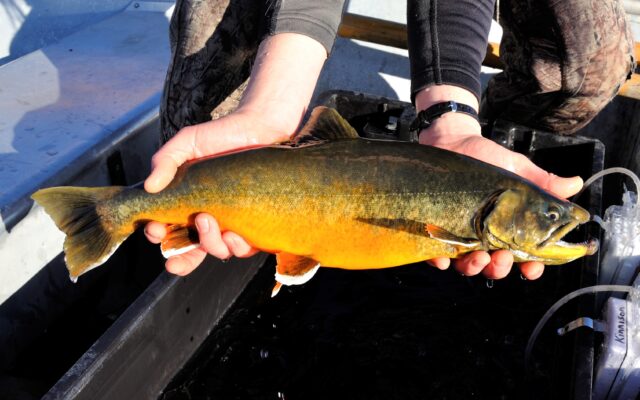
Rare Arctic charr deserve better protection under Maine fishing regulations
By Bob Mallard
Maine fishing regulations consider Arctic charr part of the brook trout family, along with splake and actual brook trout. But the fish are unrelated and face different conservation needs.
Brook trout are relatively common in Maine. Splake are a hatchery-raised hybrid. Arctic charr, on the other hand, are an exceedingly rare fish, occurring in just 12 native waters in Maine. They are also a state level Tier 1 (Highest Priority) Species of Greatest Conservation Need.
In the General Fishing Laws and Definitions section of the Maine Department of Inland Fisheries and Wildlife fishing rules it says, “Brook Trout: The term ‘brook trout’ includes brook trout, splake and Arctic charr (Sunapee trout and blueback trout).” The General Law Daily Bag, Possession and Length Limits section states, “Brook Trout (includes Splake & Arctic charr).”

ARCTIC CHARR OR ‘BROOK TROUT’ — Rare Arctic charr such as this one are currently lumped under “brook trout” in Maine’s fishing regulations.
Brook trout and Arctic charr are no more related to each other than they are to lake trout. And splake are more closely related to brook trout and lake trout than Arctic charr. So, why does DIF&W lump them all together from a fishing regulations standpoint?
DIF&W defends its position in regard to the multi-species definition of brook trout that includes splake and Arctic charr by saying that anglers cannot tell one from the other.
However, this is not how they treat other similar-looking species.
For instance, DIF&W differentiates between sea-run Atlantic salmon and landlocked salmon in the fishing rules. They not only look alike, but they are virtually indistinguishable from each other. In fact, DIF&W refers to the latter as “landlocked Atlantic salmon” on their species profile page. They go on to say, “Landlocked salmon are a freshwater form of the sea-run Atlantic salmon.”

Many anglers can’t tell the difference between brown trout and landlocked salmon. However, they are separated from a regulations standpoint by DIF&W, each with its own general law. You could make the same argument for splake and lake trout. While splake can look like a brook trout, they can also look like lake trout.
And again, both have their own general laws.
The general law for “brook trout” is five fish with a six-inch minimum length limit. In addition to being the default when a water does not have special regulations, that is also the aggregate daily limit and possession limit. Since all but one of the native Arctic charr waters open to fishing have a two-fish daily limit, theoretically, you could legally take two charr from two waters and one charr from another. With four native charr waters within a couple of miles of each other in the Deboullie region, filling your daily limit is not an impossibility, especially as anglers get better at targeting charr.
While I have issues with regard to a five-fish, six-inch limit on any wild native salmonid, I am especially concerned about Arctic charr, a notably rare and stressed species. In addition to the potential biological impact, what kind of message are we sending when we group a rare species with a hatchery-raised hybrid?
In early 2020, I was part of a working group put together by DIF&W that looked at how we were managing Arctic charr. The group requested that DIF&W split out charr from brook trout and splake in the general law. In the Goals, Objectives & Conservation/Management Strategies section of Managing Maine’s Inland Fisheries into the Future — Volume I, released after the working groups convened, DIF&W says, “Explore opportunities to provide separate size/bag listing for charr in the fishing law book,” listing it as a “Moderate Priority.”
Interestingly, the working group formed to address brook trout made the same request. In the same document under a section called “Increase public awareness and stewardship of Maine’s brook trout resource,” DIF&W says, “Explore opportunities to provide separate size/bag listing for brook trout in the fishing law book,” also listing it as a “Moderate Priority.”
More than three years later, nothing has changed.
Unlike many definitions in the DIF&W fishing rules that are in statute under Title 12, and require legislative action to change, the term “Brook Trout” is not in statute and can be changed without legal implications.
The changes required to separate Arctic charr from brook trout and splake are pretty straightforward. Change the definition for brook trout in the General Fishing Laws and Definitions section to read, “Brook Trout: The term ‘brook trout’ includes brook trout and splake,” and the General Law Daily Bag, Possession and Length Limits to say, “Brook Trout (includes Splake).
DIF&W could then create a definition for Arctic charr that mimics what is currently stated under brook trout: “Arctic charr (Sunapee trout and blueback trout).” The general law for Arctic charr could reflect what is in effect for most charr waters (two fish, six inches) while increasing protection for this rare fish by lowering the aggregate daily limit.
Only Wassataquoik Lake, which has a five-fish daily limit that would exceed the new general law limit of two fish, would require a rule change. When you consider its location deep in the backcountry of Baxter State Park, this would not present a hardship to anyone. Administratively, Bald Mountain Pond, Black Pond, Penobscot Lake and Rainbow Lake would require a special Arctic charr regulation that mimics what is already in place for brook trout.
Arctic charr should not be lumped in with hatchery-raised hybrid splake. They deserve to stand on their own, while receiving more protection than they are getting today in regard to the daily bag/possession limit. A general law specific to Arctic charr would be a great place to start.